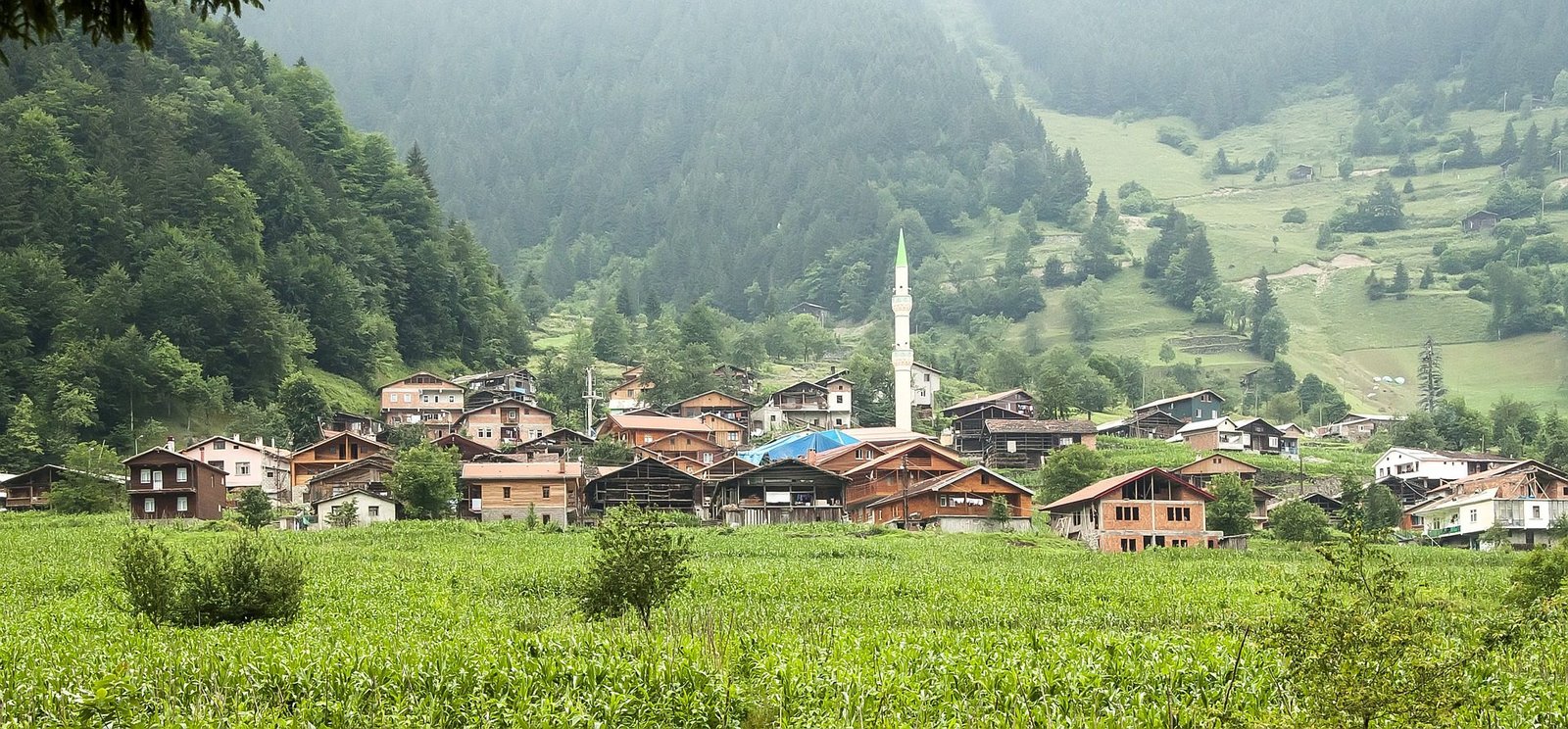Some say that the name of the city comes from the Greek “Trapezous”; “trapezion” is the table, and the ending “-ous” means “the place which possesses/has something” (eg. Kerasous; the place that has cherries, todays Giresun). Trapezous indicates the flat hilltop in the old city, which is surrounded by the medieval wall.
History
When the Roman Empire was divided into two at the end of the 4th century, Trabzon remained under the sovereignty of the Eastern Roman Empire which later on was called as Byzantine Empire. When relations and wars between the Byzantines and the Arabs started, the Arabs called the people under the Roman Sovereignty as Rum, and the areas under the Roman sovereignty as Diyar-i Rum or Memleket-ul Rum (land of Rums). Also Turks used the word Rum, hence the Province of Anatolia was called as Eyalet-i Rum and Sultan-i Rum.
The Byzantines gave special importance to Trabzon from the military point of view. During the reign of Emperor Justinian in the 6th century the city walls were thoroughly repaired and enlarged. A road from Trabzon to Persia was opened. Huts for defense were built at bends and effort was given to establish Christianity so that the tribe Can, the dwellers along the road would be obedient. Aqueducts of Saint Eugenius were built.

Black Sea, Trabzon, Photo by Eylül Yorgancı
In the 8th century the Moslem Arab armies entered Anatolia, invading the area around the citadel in Trabzon. They saw hazel nuts for the first time. In the 9th century the Moslem Turkish armies started coming to the Trabzon area and outer part of the citadel went under the sovereignty of the Turks. Inside the citadel there were still the Greek colonists. It is in this period that construction of the Saint Ann Church in Ayvasil district was completed.
In the 10th century Islamism outside the citadel speeded up and the Turks around became Moslems. Two of the four routes of the Seljuk raids which began in the 11th century passed through the Eastern Black Sea region. Canik was one of the eight provinces conquered by the Turks in Anatolia and the name Turkey was given for the first time in 1081. Its principal city was Trabzon (the name Canik derived from the word Canika, the place where the Can Tribe lived near Macka area in the south of Trabzon) and moved to the west and named as Samsun later on. In the second half of the 11th century, there were two Trabzon’s: The outer part of the citadel was under the sovereignty of the Danismeds; The inner part of the citadel was under the sovereignty of the Byzantines.
After the fights over the throne started in Byzantium (Istanbul) in the 12th century, the Commenos family was dethroned and young Alexis Commenos escaped to Georgia. He declared his Kingdom in Georgia in 1204 and came to Trabzon with the help of Christian Georgians. He took the citadel from the Byzantian governor who was at his side and made Trabzon the capital of his Kingdom; the state of Trabzon emerged. As the King was a Christian Anatolian, the state was also called as the Trabzon Rum State and later on as Rum Pontus state.
n the 13th century the Seljuk Turks besieged Trabzon twice and bound them to tax. The King of Trabzon, Alexis Commenos, fortified the citadel and ditches were dug around it. The outer part of the citadel became a large commercial city and was mentioned as “The pupil of whole Asia”. The palace of the King and official buildings were placed on the high plains of the inner fortress. The commercial life of the country that extended from Batum to Kerempe including Crimea which was in the hands of the Genoese and the Venetians. On the coast of the city there were castles and warehouses.
In the mid-13th century the Trabzon state was surrounded by the Cepnis. The Cepnis under the sovereignty of the Sungurlu tribe, from the Ucok subdivision of the Oguz division, who was the son of Kara Han and the grandchild of Turk Han, settled down on the borders of Trabzon state. While there were Christian Kings in the inner citadel, Islam was spreading quickly in the outer citadel. Ahi Evren Dede, an Islamic missionary, was buried in Boztepe after his death in the 14th century.
Moslem pirates, coming particularly from Sinop, were raiding the coasts and plundering Trabzon which became the center of Europe-Asia trade. The King of Trabzon, Alexis Commenos II (1297-1333) who had the Giresun castle built, had constructed walls against the sea which is supposed to be the Moloz District now. In the beginning of the 15th century Tamerlane invaded Anatolia and captured Trabzon too. But he did not add it to his Empire, he taxed it under the administration of his son, Halil Mirza.
Trabzon is one of the major cities of Turkey and the biggest one in the Eastern Black Sea region. Its population is over 808 thousand (2019) living on an area of 4,664 km2. Due to the rainy climate even in the summer months, it has lots of green forests and mountains with many rivers and highlands. There are major roads connecting Trabzon to other cities, a big harbor for international shipping traffic in the Black Sea, and an international airport. The city is famous for its fish, football (soccer) team, and the Sumela Monastery.
Some say that the name of the city comes from the Greek “Trapezous”; “trapezion” is the table, and the ending “-ous” means “the place which possesses/has something” (eg. Kerasous; the place that has cherries, todays Giresun). Trapezous indicates the flat hilltop in the old city, which is surrounded by the medieval wall.

Trabzon, Uzungol | Image by Kenan Tekin from Pixabay
Things to see in Trabzon
Sumela Monastery
The most famous site to see in Trabzon. The Sumela Monastery must be number of on anyone’s list. The monastery overlooks Trabzon from a cliff edge. It’s dedicated to the Virgin Mary built by the Greek Orthodox in 386 AD at an altitude of 1,200 meters (3,937 feet) located in Altindere National Park.
Trabzon Castle
The castle dates back to the Byzantine empire a structure made up of 3 fortresses experts believe it dates back to 2000 BC when it was used as an acropolis. Alexios II of Trebizond built the middle and lower fortresses, while the tuğra (signature) of Ottoman sultan Mehmed II is visible at one of the gates.
Trabzon Ayasofya Museum
Located in Trabzon originally built as a church it was converted into a mosque in 1584. The structure dates back to the 13th century when Trabzon was the capital of the Trebizond Empire. The converted church is located close to the sea and it’s considered to be one of the most beautiful examples of Byzantine architecture.
Vazelon Monastery
Many historians believe the money earned from the Vazelon Monastery was used to construct the Sumela Monastery. The Vazelon Monastery is known to be the wealthiest Greek Orthodox monasteries in the region.
Ataturk Mansion Museum
Known in Turkish as ‘Atatürk Köşkü Müzesi’ was built as a summer home for a Greek banker in 1890. The mansion was designed by Italian architects was later where Mustafa Kemal Ataturk himself would stay in 1924. The mansion in 1987 became a museum of archaeology and ethograpy.
Uzungol
Uzungol a village surrounded by mountains and a large lake in the middle is one of the most photographed places in Trabzon. The village is very popular amongst hikers as it offers great views and trails.
Airport Name: Trabzon Airport
Address: Konaklar, 61010 Merkez/Trabzon, Turkey
Code: TZX
Elevation: 32 m
Phone: +90 462 328 09 40
Serves: Trabzon and the surrounding area
We highly recommend booking international and domestic flights with Turkish Airlines. Visit www.turkishairlines.com for prices and times.
If you wish to travel by bus or car please give the details of your journey so we can recommend a local transfer service. You must allow 3 days for us to make suggestions.
All companies we recommend are licensed by TURSAB. It is merely a recommendation we do not take any responsibilities for any of the services recommended on this website.
For areas to visit near Trabzon visit https://visit-turkey.org/destination/black-sea/



